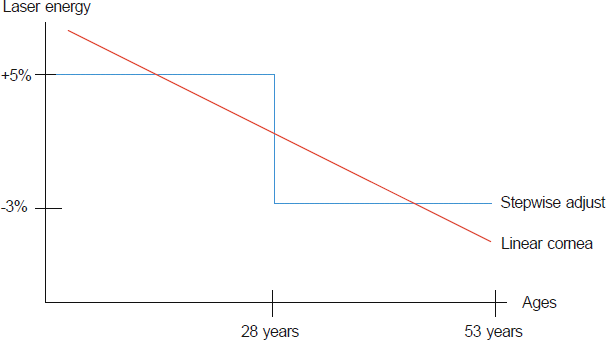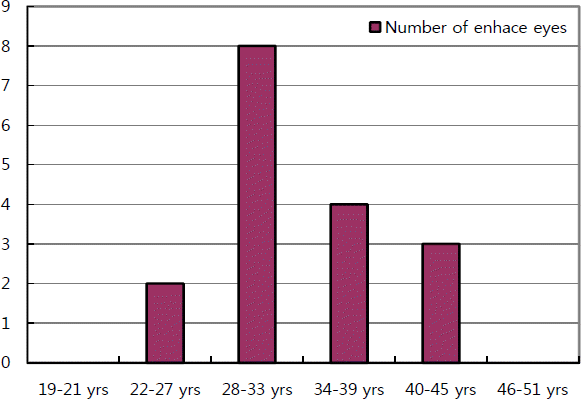Abstract
Purpose
To evaluate the clinical effects of an automatic energy-lowering system in patients over the age of 28 years with Schwind Amaris laser platform by analyzing the enhancement operation rate according to age.
Methods
A total of 20448 eyes from 10224 patients who received a bilateral LASIK or LASEK operation with the Schwind Amaris laser platform between August 2007 and April 2011 in our clinic were included in the present study. The rate of enhance operation due to undercorrection was analyzed to determine whether the age affects the enhancement operation rate.
Results
There were a total of 17 enhancement operations. Fifteen out of 17 eyes who received the enhanced operation were above the age of 28 years (p=0.005). In multivariate analysis, patient age over 28 years (OR=6.75, CI 1.54-29.60, p=0.011), preoperative higher spherical equivalent (OR=0.56, CI 0.41-0.77, p=0.0004) and preoperative higher mean keratometric value (OR=1.38, CI 1.01-1.88, p=0.043) were significantly associated with a higher enhancement operation rate.
Conclusions
Surgeons should be aware that the amount of laser energy from Schwind Amaris laser platform is automatically reduced in patients above the age of 28 years. Therefore, the nomogram should be adjusted to reduce the enhancement operation rate for a specific age group, especially in patients with higher preoperative myopic errors and steeper cornea.
J Korean Ophthalmol Soc 2013;54(2):224-230
References
1. Nassiri N, Safi S, Aghazade Amiri M, et al. Visual outcome and contrast sensitivity after photorefractive keratectomy in low to moderate myopia: Wavefront-optimized versus conventional methods. J Cataract Refract Surg. 2011; 37:1858–64.

2. Gambato C, Catania AG, Vujosevic S, Midena E.Wavefront-optimized surface ablation with the allegretto wave eye-Q excimer laser platform: 12-month visual and refractive results. J Refract Surg. 2011; 18:1–4.

3. Reinstein DZ, Archer TJ, Gobbe M, Johnson N.Accuracy and reproducibility of artemis central flap thickness and visual outcomes of LASIK with the Carl Zeiss Meditec VisuMax femtosecond laser and MEL 80 excimer laser platforms. J Refract Surg. 2010; 26:107–19.

4. Blum M, Kunert K, Gille A, Sekundo W.LASIK for myopia using the Zeiss VisuMax femtosecond laser and MEL 80 excimer laser. J Refract Surg. 2009; 25:350–6.

5. McAlinden C, Skiadaresi E, Moore JE.Visual and refractive outcomes following myopic laser-assisted subepithelial keratectomy with a flying-spot excimer laser. J Cataract Refract Surg. 2011; 37:901–6.

6. McAlinden C, Skiadaresi E, Pesudovs K, Moore JE.Quality of vision after myopic and hyperopic laser-assisted subepithelial keratectomy. J Cataract Refract Surg. 2011; 37:1097–100.

7. Arba Mosquera S, de Ortueta D.Correlation among ocular spherical aberration, corneal spherical aberration, and corneal asphericity before and after LASIK for myopic astigmatism with the SCHWIND AMARIS platform. J Refract Surg. 2011; 27:434–43.

8. Arba-Mosquera S, Arbelaez MC.Three-month clinical outcomes with static and dynamic cyclotorsion correction using the SCHWIND AMARIS. Cornea. 2011; 30:951–7.

9. Arba Mosquera S, Arbelaez MC.Use of a six-dimensional eye-tracker in corneal laser refractive surgery with the SCHWIND AMARIS TotalTech laser. J Refract Surg. 2011; 27:582–90.

10. Aslanides IM, Toliou G, Padroni S, et al. The effect of static cyclotorsion compensation on refractive and visual outcomes using the Schwind Amaris laser platform for the correction of high astigmatism. Cont Lens Anterior Eye. 2011; 34:114–20.

11. Arbelaez MC, Vidal C, Arba Mosquera S.Comparison of LASEK and LASIK with thin and ultrathin flaps after excimer laser ablation with the SCHWIND Aspheric ablation profile. J Refract Surg. 2011; 27:38–48.

12. Mrochen M, Hafezi F, Iseli HP, et al. Nomograms for the improvement of refractive outcomes. Ophthalmologe. 2006; 103:331–8.
13. Farah SG, Azar DT, Gurdal C, Wong J.Laser in situ keratomileusis: literature review of a developing technique. J Cataract Refract Surg. 1998; 24:989–1006.

14. Hu DJ, Feder RS, Basti S, et al. Predictive formula for calculating the probability of LASIK enhancement. J Cataract Refract Surg. 2004; 30:363–8.

15. Patel NP, Clinch TE, Weis JR, et al. Comparison of visual results in initial and re-treatment laser in situ keratomileusis procedures for myopia and astigmatism. Am J Ophthalmol. 2000; 130:1–11.

16. Randleman JB, White AJ Jr, Lynn MJ, et al. Incidence, outcomes, and risk factors for retreatment after wavefront-optimized ablations with PRK and LASIK. J Refract Surg. 2009; 25:273–6.

17. Lyle WA, Jin GJ.Retreatment after initial laser in situ keratomileusis. J Cataract Refract Surg. 2000; 26:650–9.

18. Patel NP, Clinch TE, Weis JR, et al. Comparison of visual results in initial and re-treatment laser in situ keratomileusis procedures for myopia and astigmatism. Am J Ophthalmol. 2000; 130:1–11.

19. Saeed A, O'Doherty M. O'Doherty J, O'Keefe M. Laser-assisted subepithelial keratectomy retreatment after laser in situ keratomileusis. J Cataract Refract Surg. 2008; 34:1736–41.
Figure 2.
Comparison of linear cornea biomechanics change with age and stepwise auto adjustment of laser energy of Schwind Amaris. The lower triangle may explain relatively high enhancement procedure rate at this age range.

Table 1.
General characteristics of 20448 eyes of 10224 patients who received LASIK or LASEK operation with Schwind Amaris laser platform
Table 2.
Analysis of operation methods of 10224 patients who received LASIK or LASEK operation with Schwind Amaris laser platform according to age groups
Table 3.
General characteristics of 17 eyes of 11 patients who received enhancement procedure because of undercorrection within 1 year after LASIK or LASEK operation with Schwind Amaris laser platform
Table 4.
The analysis of primary operation method and age distribution of 17 enhanced eyes after LASIK or LASEK operation with Schwind Amaris laser platform
| Characteristics | Primary operation method (Numbers of eyes) | ||
|---|---|---|---|
| LASIK | LASEK | Total | |
| ≤27 years | 1 (5.9%) | 1 (5.9%) | 2 (11.8%) |
| ≥28 years | 10 (58.8%) | 5 (29.4%) | 15 (88.2%) |
| Total | 11 (64.7%) | 6 (35.3%) | 17 (100%) |
Table 5.
Enhancement procedure rate after LASIK or LASEK with Schwind Amaris laser platform according to age at primary operation
Table 6.
Comparison of parameters between enhanced group and unenhanced group (enhanced group = 17 eyes, unenhanced group = 20431 eyes)
Table 7.
Clinical characteristics associated with enhancement procedure rate in patients who received Schwind Amaris LASIK or LASEK




 PDF
PDF ePub
ePub Citation
Citation Print
Print



 XML Download
XML Download